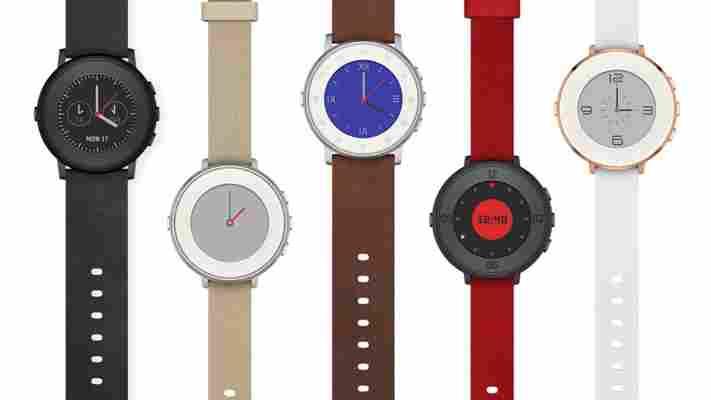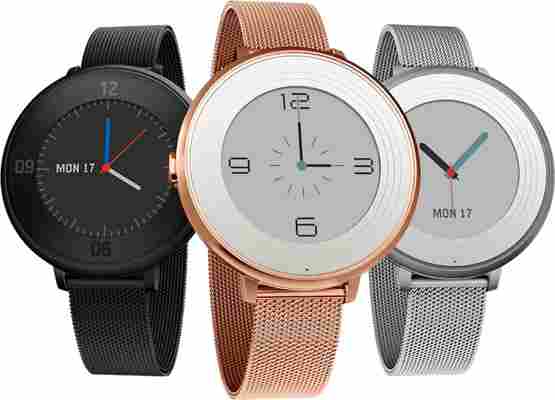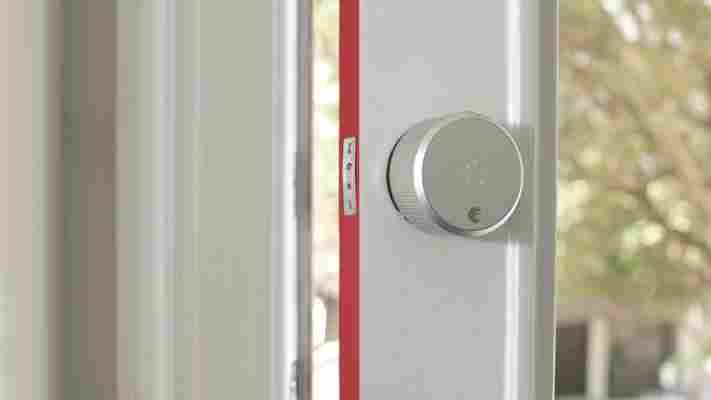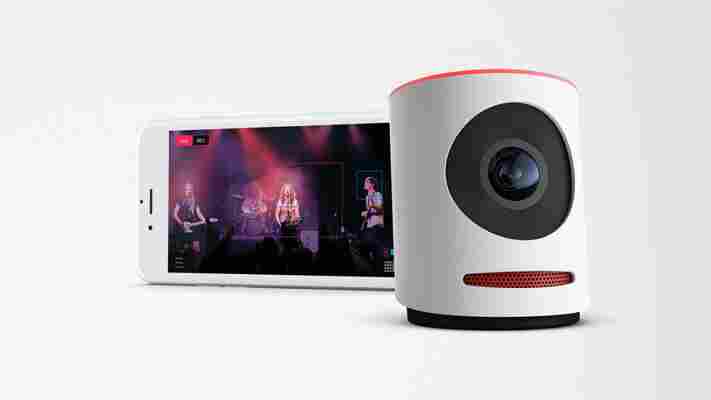Pebble has made its first round smartwatch available through its online store today.

You can now order the Pebble Time Round on the company’s site for $249.99 in a range of colorways, and it’ll ship in two to four weeks. The wearable will also be available on Amazon, Best Buy and Target’s online stores soon.


If you’d like to see how it looks on your wrist before you buy it, you can try it at Target and Best Buy stores across the US from November 8.
Announced in September , the company claims the Time Round is the lightest and thinnest smartwatch in the world: it’s 7.5mm thick and weighs 28 grams.
It features a color e-paper display, offers two days of battery life on a full charge and works with Android and iOS devices.
Besides making the watch available in brick-and-mortar stores, Pebble says it will also start shipping pre-orders from its launch announcement on November 8 as well.
➤ Pebble Time Round Lands in Retail and Starts Shipping November 8th [Pebble Blog]
Review: August Smart Lock with HomeKit is (mostly) a dream come true
Of all the smart home gadgets you can buy, the door lock remains the holy grail. Coming and going without ever touching keys is something we crave for some reason, and August is our best crack at it .

And its new HomeKit enabled lock is supposed to bring something extra to the mix in Siri. Still, the Internet of Shit Things is a mixed bag, but August may be its rare bright spot.
If you’ve seen an August lock, there’s nothing new with the HomeKit version. It still looks like the sexiest, most metal roll of duct tape you can hang on your door lock.
In addition to the lock, August also provided its keypad. The rectangular device is meant for use on the other side of your door, and does exactly what you’d expect: let’s you enter your home using a code instead of a key or the August app.
I should also note installation was insanely simple. You’ll feel like you’re doing something wrong — because a smart gadget should be confusing and complicated, right? — but you’re not. It’s really as easy as taking your inside lock off and putting August on. If you need to manually lock or unlock the door, turning the outside barrel gets the job done.
August’s app is nothing to write home about. It’s serviceable for locking and unlocking your door, granting access to new users, or toggling your settings.
If you’re in a dense urban environment with access to a lot of services (so, San Francisco or New York), August also has an ‘ Access ’ option that lets you grant access to Postmates delivery people or Handy cleaning crews (but be careful, there).
There’s also a guest book if your pals want to leave notes for you after staying over, and an activity log. The app is also where you’ll manage the keypad and smart doorbell, another August add-on for the smart home. And if you’re into wearables, the Apple Watch has a glance for August.
Tweak August’s settings, and true automation (almost) becomes a reality.
You can have the lock unlock itself when you’re near it, and lock automatically after a set time after it’s been opened. In my case, I have it unlock when I’m within 100 meters, and lock 90 seconds after I unlock it.
When I leave home, I simply close the door behind me and trust August to lock itself. The beauty in that feature is that it doesn’t require connectivity, so I know it’ll happen.
Unlocking is a bit trickier; on a few occasions, the lock doesn’t unlock itself until I’m standing at my front door. Others, it’s unlocked itself when I’m in the parking lot of my apartment complex.
A few times, it’s failed altogether, leaving me to dig my phone out and try the app. The issue there is that the app needs to discover the lock each time you open it, and it’s not always quick. In those instances, keys are faster — and we’re back to square one with the smart home.
You should also be mindful of what you’re asking August to do. If you were to close the front door behind you as you went to mow the lawn — but didn’t bring your phone — there’s a chance you’d lock yourself out of your own home if auto-lock was enabled.
The keypad is also hit-and-miss at times. I’ve gone to enter my passcode only to find the keypad blinking at me as if it had no lock to pair with (even though the app noted it was paired). Other times, it was as smooth an experience as you’d expect the smart home to offer; I enter a code and my August lock twirls to let me into my home.
Siri is Apple’s lynchpin for your connected home, so long as you have the new Apple TV , which serves as a hub for the connected home in Apple’s HomeKit framework.
Within the August app, you’ll be asked to name your door lock. Once you do, you can ask Siri things like “is (whatever you named your front door) locked?” which should return a yes or no answer.
You can also ask Siri to lock or unlock your front door — but that’s about it. Sounds simplistic, but what can we really expect of a connected door lock, right?
Outside of your personal needs, there are times this could be handy. Say a friend forgot something at your house, and really needs to get it — but you’re at work. You could unlock the door from afar once they reach your entry, granting them access without giving them a key or disrupting your day.
The August app also keeps a log of when the door was locked and unlocked, so if that friend lingered in your apartment longer than it took for August to re-lock itself, you’d know.
August isn’t perfect. There were times when it failed to unlock automatically, and the keypad just seemed to be out to lunch. The app also seemed lost when trying to find the lock on a few occasions.
In those moments, it’s clear that connectivity isn’t going to satisfy our desire to have an automated home. As I write this, my service provider (Comcast) is having a major outage in my area, and that jeopardizes some of what August is capable of (HomeKit and August Connect, specifically; the geo-location used for auto-unlock relies on Bluetooth).
I’ve also left my keys at home several times in the process of testing August’s new HomeKit enabled lock and had no problems. But each time, I remind myself that maybe it’s a good idea to hide a key somewhere near my front door just in case.
Happily, those ‘just in case’ moments are sparse. August shines more often than not, and in a strange way its rare failures are how I know it’s a success. I only really think about Comcast as my ISP when it’s down, and I only really consider my connected lock fussy when it fails.
Most of the time (a solid 97 percent, I’d say), August unlocks as I approach it and locks behind me when I close the door. The keypad is less reliable, but has been much better after the latest app update which ushered in HomeKit (and I’m guessing some connectivity tweaks that help keypad work better).
For $229, August is something I can recommend anyway, and HomeKit makes it that much better (if you don’t have HomeKit, August sells a $79 plug-in dongle that links the lock to Wi-Fi, offering the same functionality). Barking ‘hey Siri, unlock my door’ while driving is oddly satisfying.
The ‘wow’ factor is there, too. Friends are impressed enough to lust after August, even when it’s not at its best.
If you need a takeaway, here it is: I test a lot of gadgets, and August is one of the only that doesn’t make me think ‘so what is this thing really good for?’ when I look at it. More often than not it’s just sitting there on my door, reliably locking and unlocking without me prompting it to do a thing.
Which is exactly what I want.
Update : This article was updated to clarify some technological points on August’s auto-unlock feature.
Livestream’s $399 Movi camera lets you edit 4K footage while you shoot
If you frequently shoot videos of live events, you’ll want to check out Livestream’s Movi . The streaming video company’s new device, slated to be announced at CES this year, lets you capture footage and use editing features on-the-fly.

The $399 Movi packs a 4K sensor, stereo microphones and a 150° all-glass lens and can be controlled via an iOS app. While shooting, you can direct the camera by interacting with the preview on your phone. Zoom into a subject, tap on an area to cut to it and drag to pan across a scene.
https://youtu.be/9PWQ__2nuf8
The company says it can also detect faces and track movement, so it should come in handy if you’re shooting concerts or fashion shows and want to shoot a single person. It’s also said to be capable of detecting when someone is speaking so it can focus on them automatically at, say, a press conference.
Movi lets you either stream your footage live via a connected smartphone or share it at a later time. It can only run for an hour on a full charge, but works with the Boost accessory for longer battery life as well as ethernet and LTE connectivity.
On its own, the Movi could help free you up while you’re covering an event and make your videos look more lively — but to say that it can replace a multi-camera setup would be a stretch. The company told TechCrunch that it might add a feature so you can use several Movis in tandem and cut between them, but it won’t be available at launch.
Livestream’s Movi will be available in April for $399, but you can pre-order it now on the company’s site for $199 .
Don’t miss our coverage of CES 2016 >
➤ Movi [via TechCrunch ]
